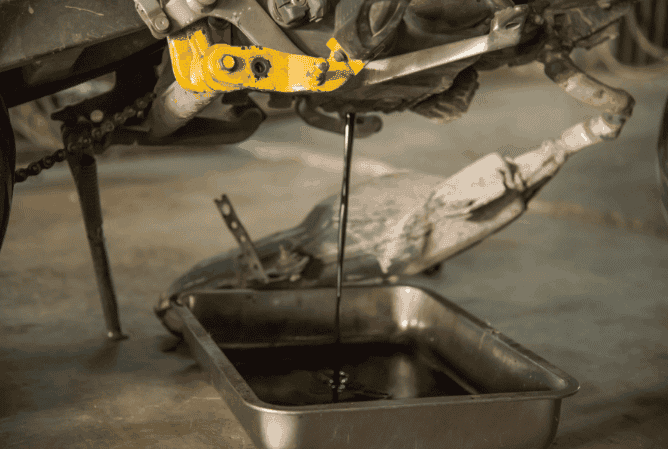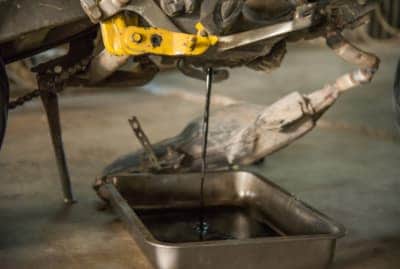
Oil is an integral part of your motorcycle’s engine operation. The thing about oil is that it does eventually break down and become less effective. Because of this, oil is designed to be changed to prolong the life of the engine.
What are the signs that your motorcycle needs an oil change? Signs that your motorcycle needs an oil change include, the oil in the engine is black and thick due to it being full of dirt and dust. The warning lights are on, signaling that it’s time for an oil change. Or there is more engine noise than is considered normal because the oil is no longer lubricating the engine.
It might look challenging at first to determine if your bike needs an oil change, and then fix it. But it is a relatively quick fix that you can learn from this article.
Signs That Your Oil Is Overdue
If it has been a while since the last oil change, it is a good idea to check the oil. Here are a few conditions you might find that indicate if an oil change is necessary:
Oil is black and thick. Pull the dipstick up and see what your oil looks like. If it is really black and thick, it is probably due for a change. The blackness comes from dirt, dust, and carbon deposits. These contaminants also change the thickness and affect the overall lubrication of the engine.
Warning Lights. Most modern bikes will have an oil pressure sensor. This detects the pressure of the oil and sends an alert if it drops too low. Low oil pressure is indicative of a few different, yet serious problems, so pay attention to the light that is typically shaped like an old-fashioned oil can. The most common reason for this light is low oil level as it slowly burns or leaks out.
Excessive engine noise. When the lubricating effect of the oil is degraded, it allows metal-to-metal contact, which creates more noise than usual. This will usually be more pronounced in the top end of the engine where the camshaft and valves usually are. As you can imagine, this condition is not ideal and will shorten the lifespan of the engine if left unfixed.
The internal combustion engine has been engineered over the past century to implement principles of physics, including fluid mechanics. It turns out that oil is non-compressible and therefore can be used as a bearing. This greatly reduces friction between metal parts that would otherwise quickly heat up and wear out.
If that seems like rocket science, just know that oil is important for your engine. Furthermore, using the right grade of oil is important. Engines have very small passages and channels so the right thickness of oil is required. Almost all commercially available oils meet a universal standard of quality and follow consistent grades. Some common grades of oil for motorcycle engines are
- 10W-30
- 10W-40
- 20W-50
These numbers represent different viscosity and the W number represents the viscosity in cold weather. There are oils designed specifically for motorcycles in contrast to car engine oil. Since motorcycles often use engine oil to lube the transmission, it requires specific additives that are not found in car engine oils.
There are also different types of oil, including mineral oil/conventional, synthetic, and semi-synthetic. This refers to the kind of oil used as a base to carry different additives. Mineral oil is derived from petroleum refineries and is a very common type of oil. Synthetic oil has been chemically engineered to mimic conventional oil.
It is really important to follow the manufacturer’s recommendations for oil grade. The tolerances, or space between, engine parts is quite small, as in fractions of an inch. Engineers design such tolerances to use a specific grade of oil. Refer to your owner’s manual or a trusted source for your bike’s oil type and quantity.
It is often debated about which brand is superior, but this has more to do with the user’s preference. The difference in brands is mostly what additives they add and less about the actual quality of the oil. Find a brand that you like and stick with it.
How Often To Change The Oil
The frequency of oil changes will depend on the type of oil and the riding conditions. You should always change the oil at least once per year, even after low-mileage riding. Otherwise, follow your manufacturer’s recommended guidelines.
If you don’t know what is recommended, here are some good rules of thumb to follow. During normal riding conditions, change your oil every
- 2000 miles for conventional (mineral) oil.
- 5000 – 6000 miles for synthetic blend oil.
- 7000 – 10,000 for full synthetic.
Conventional oil tends to break down quicker than synthesized oils and therefore goes fewer miles before requiring changing. Synthetic oil stretches out the lifespan of the oil with different brands, all claiming different mileages. However, more frequent changes will keep fresh oil in your engine, so err on the side of caution.
To keep up with the maintenance of your bike, you will want to regularly change the oil. Here are some ways to measure the frequency of oil changes:
- Mileage since last change.
- This is the best way to track oil life and manufacturers base their recommendations on mileage. Mileage is used because it is a simple way to know the work that the oil has been through and how much it has degraded. Going over the mileage interval is not going to be catastrophic, but keep it as close as possible.
- Date since last change
- If you don’t put a lot of miles on your bike, using time is another simple way to measure the life of the oil. In this case, it is better to change it more often than not.
- Oil level and condition
- Looking at the condition of the oil on the dipstick can help you know if the oil needs changed, but it is a bit unreliable. On a newer engine, it will be easy to see the oil stay cleaner longer. However, on older engines, the oil will become darker sooner, but that doesn’t always mean that it is bad.
- Similarly, if the oil level changes, you might want to think about changing it. This may also indicate a deeper problem. If the level is low, then oil may be getting burned or leaking out of the engine. If the level is rising, then the oil may be diluted and is therefore ineffective.
- Engine rebuild
- If you have a freshly rebuilt engine, it is really important to keep up with the oil changes. Immediately after rebuilding, there is a break-in period in which special break-in oil is used. This is usually a shorter interval compared to regular oil changes. After the break-in period, you will want to diligently keep the oil fresh as this will maximize the life of your freshly rebuilt engine.
If you are ever in doubt, it is worthwhile to change the oil. Changing oil is usually inexpensive to do yourself if you are on a budget. Otherwise, take it to a competent mechanic who can also check for other potential issues with your bike
Why Oil Is Important
Oil is integral to engine operation and maintaining it is the best way to extend the life of your bike. Neglecting the oil will not only shorten the life of your bike but will also decrease the performance of your bike. Along those lines, if you can’t take good care of your bike, it decreases the potential resale value should you need to get rid of it.
Some people might neglect oil maintenance because they are unsure what to do about it. Here are three steps to take if you happen to find yourself in this situation. First, think back to when it was last changed and calculate when it’s due. If you can’t figure it out, do it anyway. Second, find a capable repair shop that can handle the job. A trained eye may also find hidden issues you may not know about. Third, make it a habit. Whether you are just getting into motorcycles or have been for a while, prioritizing maintenance will keep you on the road longer.
Conclusion
Oil is critical to your engine’s operation. It is also important for transmission operation. Keeping it fresh will keep your bike running better longer. Refer to your owner’s manual for specifics, but oil is usually changed 2000-5000 miles depending on the type of oil you use. Make sure you use the right grade of oil from a reliable brand. Doing so will maintain the value of your bike so you can enjoy the open road.

